Relations between the different ethnic groups in the region vary on the social, economic and political levels. Relations between Arabs, Kurds and Assyrians naturally evolved throughout history due to sharing one land. Each group’s existence intertwined with the other, creating forms of organization and cooperation in light of the multiple languages in the area.
School is the foundation of a human being and the cornerstone in building the culture of peoples of all regions. The importance of school lies in developing individuals and giving them a strong social, cultural and cognitive foundation.
Since societies in the Middle East are multilingual, multi-ethnic and multicultural like in al-Jazeera, schools are given an even more important role in transmitting values and encouraging coexistence.
The schools in al-Jazeera have witnessed a major shift from a curriculum with one language and national reference to a multilingual curriculum starting from primary school through to university.
Farhan Ali A School Where You Can Hear “Good Morning” in Three Different Languages
The school courtyard is filled with chatter and shouts in Kurdish and Arabic as pupils gather in a narrow space that brings together a diverse group of al-Jazeera’s children.
In Farhan Ali primary school in the al-Hilaliye neighborhood of al-Qamishli, pupils gather in the morning to greet each other in Arabic, “Sabah al-kheer”, Kurdish, “Be yani bash” and Assyrian “Bareekh safrou”.
The majority of the pupils are from villages and neighborhoods of al-Qamishli city. They eagerly come to school, motivated by social and cultural ties established by their families over many years.
Afeen Abdul Rahman, a Kurdish pupil at Farhan Ali, spoke to Enab Baladi about the educational environment at the school he attends with his Arab peers, gathered in adjacent classes and in courtyards where they do sports activities when they do not have classes. Afeen says, “I have several Arab friends. We come together to school in the morning. We play with each other and there are no differences or disputes between us. I learn Arabic alongside Kurdish.”
Although mixed schools recently established in al-Qamishli city faced some difficulties, with pupils from different ethnic groups having to adjust to the new environment, over time they have formed friendships and bonds that often surpass ties between children of one social group.
The teaching staff in Farhan Ali is made up of both Kurds and Arabs. A Kurdish teacher teaches Arabic and Kurdish to all year groups whereas an Arab teacher teaches math, science and foreign languages, according to Kurdish teacher Munifa Nawaf Ali.
Munifa told Enab Baladi, “Pupils in the school have shattered all types of discrimination and divisions between them. You always find them playing together and learning Kurdish and Arabic from each other. And each group has its own curriculum.”
A third grade Arab pupil, Mohamed, tells us, “I have a Kurdish friend called Aboudi.” He says that he has Kurdish and Arab friends inside and outside school and that he plays with them and learns from them.
Mohamed plays different games with his Arab friends during leisure time, especially “15”, a popular game in school that has the biggest impact on his character
Farhan Ali School has several classes starting from first grade through to sixth grade. The curriculum includes general principles and specific ones for each ethnic group. In the first three grades, pupils are taught in their original language and after the third grade, they are introduced to the other languages.
Sheeren Dawud, a Kurdish teacher, says, “I teach Arabic to Arab and Kurdish pupils. The school brings them together and it is our duty to gather them and strengthen their ties as classmates and friends,” She has an Arabic degree and transmits the expertise she gained during years of university to her pupils.
During our conversation with the teaching staff, Kurdish teacher Jihan Farhan tells us, “I teach Arab and Kurdish pupils in sixth grade. The pupils’ education is not limited to their mother tongue only but includes creating an educational mix of all the languages of al-Jazeera.”
Jihan confirms that the main mission of the mixed schools is to concentrate on language exchange between pupils. The Kurdish pupil has to be taught all Arabic language grammar in addition to his mother tongue and the same for the Arab pupils.
During the Syrian regime’s rule over al-Jazeera, it established several schools that instituted concepts such as “National Socialism” and did not concentrate on building the foundations of coexistence and social and intellectual proximity between different ethnic groups in the area, neglecting values and traditions entrenched in al-Jazeera for centuries.
Do You Support Mixed Schools Between Arabs and Kurds in al-Jazeera?
Syria’s al-Jazeera region has around 450 Kurdish and Arab villages and several Assyrian ones. Other villages are mixed. This created a distinctive model of social and cultural diversity interlinked with different languages, forming a bridge between the residents of each city, town or village.
Al-Jazeera is one important example of this diversity, with its atmosphere of coexistence in villages, towns and cities due to sharing one land and to linguistic exchange between the different ethnic groups.
The coexistence and social ties are reflected in the educational system in the region especially during the years of the Syrian revolution. New curricula were introduced including books and classes different from the ones used during the Syrian regime’s rule.
Before the outbreak of the revolution in Syria, the Syrian regime had banned Kurds from using Kurdish in the education system and did not give it much importance in school curricula. However, Kurds continued to hold onto their language and taught their language to their neighbors from other ethnic backgrounds.
Enab Baladi interviewed several teaching staff and families of Kurdish, Arab and Assyrian pupils in al-Hasaka and al-Qamishli districts to conduct a survey regarding mixed schools in their region, their significance and the type of curricula used. Arabic teacher Haitham Ismael says, “I support this type of teaching introduced in schools in the al-Jazeera region in an environment of brotherhood between Arabs, Kurds and Assyrians.”
However, Ismael points out, “There should be more coordination between the different groups, especially between those in charge, in relation to the curriculum and pupils’ enrollment. They are now experiencing greater stability and we want to strengthen this through joint cooperation between those in charge so that coexistence can be reflected as a fundamental pillar in our schools and curricula.”
Thabet Dawud, a resident of al-Qamishli, points out the lack of teaching staff when it comes to the Kurdish language, “For a long time, we have wanted Kurdish to be taught in schools in al-Jazeera but the main problem is that those in charge of teaching are not qualified to teach pupils.”
While introducing Kurdish language into school curricula during the years of the Syrian revolution was extremely important, according to Thabet Dawud, it should be accompanied by a methodology for mixing all pupils – Arabs, Kurds, and Assyrians. “The educational body places Kurdish pupils in separate classes form Arabs at a time when they should integrate with each other.” He added, “The curricula have to be unified to conform to the ideas of Arabs and Kurds alike.”
Al-Ghafoor Ismael, whose children go to school in al-Qamishli city, agrees that there is a need to unify the curricula. He clarifies, “The ones who will be most affected by the process of changing the school curriculum in the region’s schools are the pupils from all ethnicities.”
Ismael adds, “There should be a process to unify school curricula in al-Jazeera’s schools because having different curricula leads to completely different educational processes. If it is difficult to unify them, they should try to standardize the two curricula and give pupils total freedom to choose between them.”
Radwan Othman from al-Qamishli city told Enab Baladi that, “The first year the Kurdish curriculum was introduced to schools, we noticed that a lot of pupils signed up for it, but in the second year, it was the opposite. There was less interest in the curriculum and the number of children coming to school fell.”
Othman insisted that, “The curricula should be reviewed and a strategy should be put in place on teaching all languages in the al-Jazeera region in a way that will enrich the educational process.”
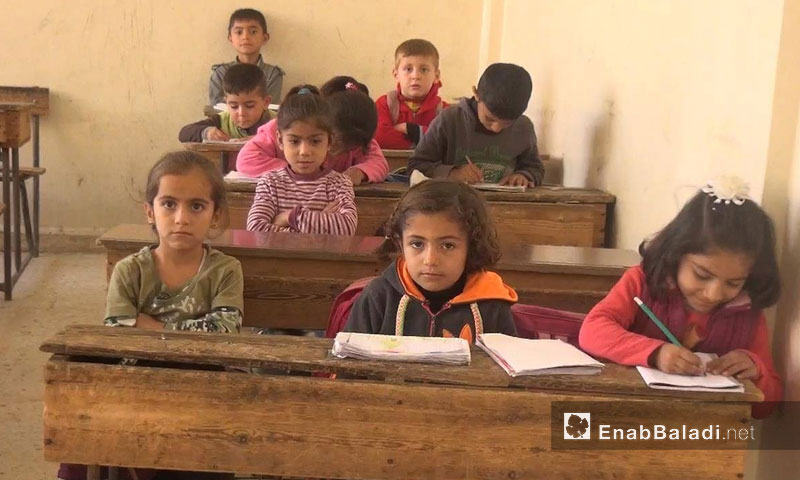
Pupils in Farhan Ali School in al-Hilaliye neighborhood in al-Qamishli – 17 November 2016 (Enab Baladi)
A Kurd Who Began His Journey as a Teacher in Arab Village Transmits His Experience to His Sons
He recalls his first years of teaching after he graduated from high school and started working as a temporary teacher in an area with a Kurdish and Arab majority, between Tal Baragh and Tal Hamees in the al-Jazeera region. The area included Arabs, Kurds and Assyrians in a diverse educational environment animated by three languages.
“I haven’t forgotten the great appreciation and respect Arab families in the area showed for Kurdish teachers who were assigned to teach in Arab schools,” Kurdish teacher Nadeem Khuder Omar said while telling us his story and the details of his educational career.
The teacher added, “In the first three months of teaching, a day would not pass by without being invited for lunch by the families of Arab pupils.”
Al-Jazeera, which hosts many Arab and Kurdish tribes, is known for the exceptionally good treatment of teachers who were assigned to teach in the villages and towns in the region.
These traditions and habits stem from respect and appreciation for these teachers regardless of their different ethnic background, whether Arab, Kurdish or Assyrian.
Appreciation and respect are not limited to the people of this region. Many teachers who were assigned to teach in Hama, Homs and Damascus say they received the same care and attention, according to Omar.
The mother tongue is considered the foundation of the heritage and values of different groups and communities in Syria’s various regions due to its close link with people’s identity be they Kurdish, Arab or Assyrian, Omar told us as he flipped the pages of a book he teaches to his Arab and Kurdish pupils including his own sons. He added, “I taught Arabic and specialized in teaching primary through to middle and high school pupils in Arabic.”
The spirit of brotherhood between communities in the al-Jazeera region is only achieved by learning each other’s languages. The Kurdish teacher continues, “The spirit of friendship between pupils increases and develops by learning all of the region’s languages through the schools that bring them together. This provides the educational resources needed to develop the level of education and culture on strong foundations and ties.”
The Syrian regime attempted to separate between Arabs and Kurds in al-Jazeera in all cultural fields and especially in education through the curriculum and through changing the historical names of Syrian regions and cities. Its policy of imposing Baathist concepts involved establishing them in the minds of children and pupils from an early age.
But during the past five years, the entire educational planning process – from schools and curricula to books and languages – has been in the hands of al-Jazeera’s residents who chose to introduce mixed schools bringing together pupils from all ethnic groups.
The conditions imposed by politics and war have created many side effects and have made it necessary to search for a new structure and foundation on which to strengthen the civilization of al-Jazeera, based on coexistence, brotherhood and friendship between different ethnic groups, as well as with other nations and civilizations.
This is what the teacher Omar Nadeem insists on, “The foundations of coexistence and social cohesion that have formed between communities in al-Jazeera have to be preserved by creating links between the children of these communities. The seeds of coexistence have to be sowed among them, to develop with them as they grow.”
1360 Mixed Schools in Al-Jazeera and a New Curriculum Introduced
The educational field in the al-Jazeera region has faced various difficulties in the past few years such as the shortage of teaching staff and the changes to school curricula adopted for the 2015-2016 academic year.
The previous school system was limited to teaching the curriculum imposed by the Syrian regime at all levels. With the outbreak of the Syrian revolution and the takeover of the region by the Autonomous Administration, Kurdish and Assyrian languages were introduced alongside Arabic in the same schools.
The mixed schools were limited to areas under the control of the Autonomous Administration. In the past few months, these have expanded to 1360 schools with 12,000 teachers distributed among them based on their different backgrounds, according to the Board of Education.
The Deputy Co-President of the Board of Education in al-Jazeera, Malek Hana, spoke to Enab Baladi about the schools and how pupils are distributed and placed in classes. “Joint schools in the al-Jazeera region are not limited to one ethnic group but are organized according to the composition of the neighborhoods in which the school is to be established.”
Cultural diversity gathered all these groups and made it essential to find a new mechanism in order to strengthen this coexistence. Hana clarifies, “Most neighborhoods in al-Jazeera have three or more ethnic groups. Basmiye and Qabrah blocks.”
Self-Administration Introduces New Educational Curricula
In the past two years, the Autonomous Administration has proposed new curricula that include teaching in Kurdish and Assyrian – languages that were previously banned – alongside Arabic.
The Deputy Co-President of the Board of Education in al-Jazeera explained the nature of the curriculum adopted in the mixed schools, “The curriculum in both Arabic and Kurdish is taught to pupils from the first grade until the sixth grade. The curriculum in Assyrian was introduced in the first and second grades only.”
He indicated that, “A pupil in mixed schools has the freedom to choose the main language to study in, in addition to a second language of his choice.”
Areas and cities in al-Jazeera have a mix of Arab, Kurdish and Assyrian groups. It is rare to find an area with only one ethnic group apart from some areas in the far northeast of the region.
The system introduced by the Joint Board of Education in the al-Jazeera region aims to “push pupils from first grade until fifth grade to learn the three main languages in the al-Jazeera region.”
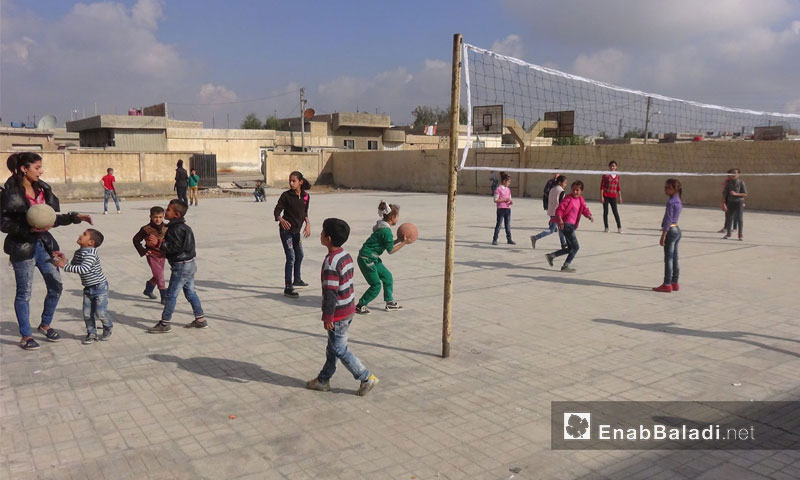
Pupils in Farhan Ali School in al-Hilaliye neighborhood in al-Qamishli – 17 November 2016 (Enab Baladi)
Hana mentions that the board has been working for approximately a year inside al-Jazeera to prepare a new curriculum and new books, pointing out that, “The curriculum draws on more than one source. It promotes democratic culture and does not impose a particular culture on all groups.”
The curriculum introduced into mixed schools in al-Jazeera’s districts included the fundamental concepts particular to each ethnic group, but it was rejected by some local residents. In addition, overcrowding in classes pushed some students to go to private schools that follow the regime’s educational curriculum, especially since these schools are more established and their qualifications are recognized more widely than the newly-established curricula.
But others see that mixed schools are the only effective way to address the deficiencies and damage faced by the education sector and to pave the way towards peaceful coexistence between ethnic groups in al-Jazeera.
This report was prepared by Enab Baladi in cooperation with Arta FM radio channel
if you think the article contain wrong information or you have additional details Send Correction
النسخة العربية من المقال
-
Follow us :
Most viewed
- Printing Syrian currency in Europe... A file on the table
- Complex steps to establish new Syrian army
- National Security Council in Syria: A necessity imposed by reality
- SDF-Damascus agreement in Aleppo: A test balloon for broader consensus
- Books make a comeback in Damascus libraries after being banned under Assad











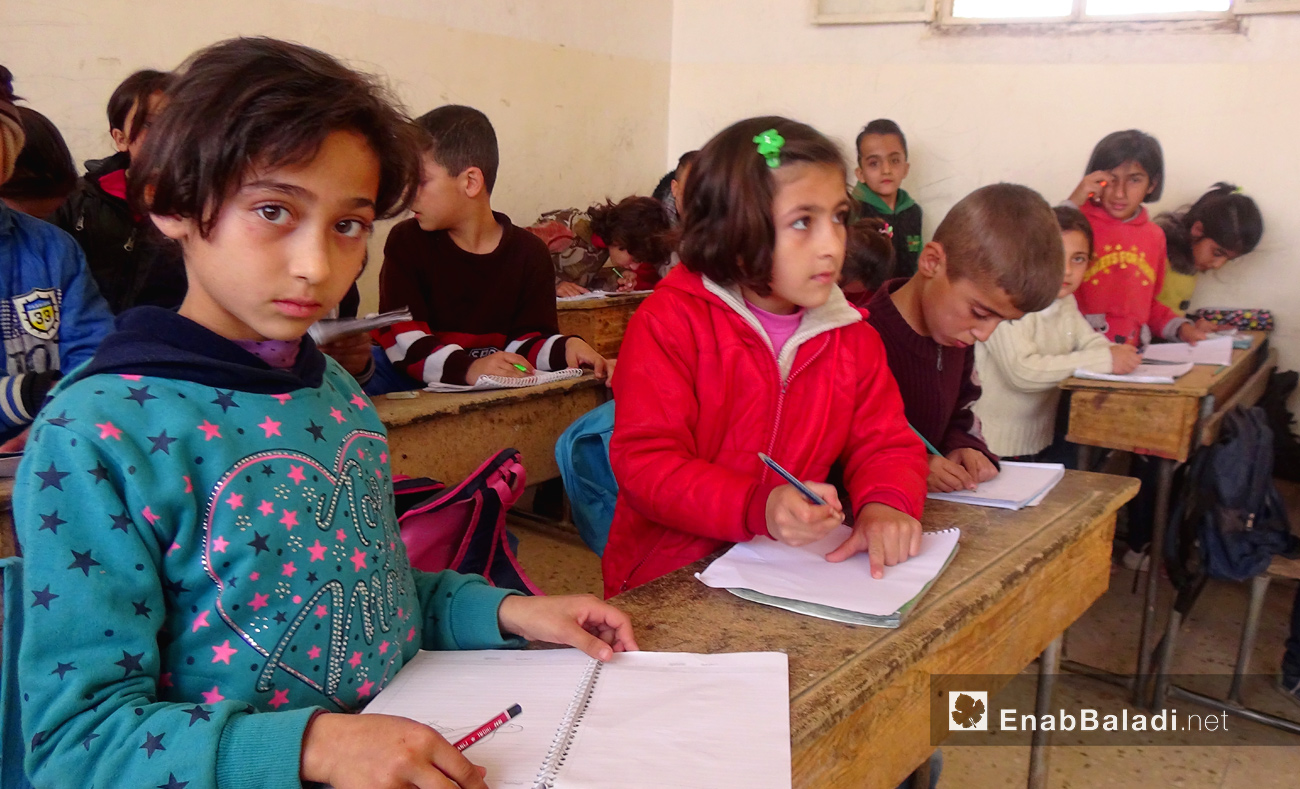
 Pupils in Farhan Ali School in al-Hilaliye neighborhood in al-Qamishli - 17 November 2016 (Enab Baladi)
Pupils in Farhan Ali School in al-Hilaliye neighborhood in al-Qamishli - 17 November 2016 (Enab Baladi)





 A
A
A
A
A
A






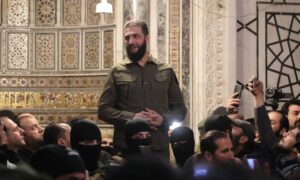
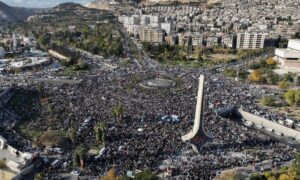
 More In-Depth
More In-Depth